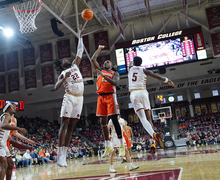London Ladd’s identity influences his latest exhibit ‘How Shall We Be Known’
Contributing Writer | Kelly Matlock
Ladd's collection "How Shall We Be Known?" is at the Community Folk Art Center through September 9 in downtown Syracuse.
Growing up biracial influenced almost all of illustrator London Ladd’s work.
“Everything about my work, even practice pieces, is primarily African American,” he said. “I’m trying to bring a sense of representation to my work, and a sense of therapy, of coming to grips with knowing who I am, because it’s always been a struggle for me as a creator.”
The Syracuse University alumnus’ latest collection of mixed-media illustrations, entitled “How Shall We Be Known?,” is on display at the Community Folk Art Center in downtown Syracuse until Friday. Ladd received a master’s in illustration from the College of Visual and Performing Arts this past academic year after earning his bachelor’s degree in 2006.
Many of the pieces in the exhibit, which focuses on African American life, are from Ladd’s graduate school thesis, which was about Black lives and the importance of accurate representation in art. Before the 1970s, white artists and authors were often responsible for Black representation in illustrations, which were typically subtly or blatantly racist, Ladd said.
The artist also based the exhibit’s title off his thesis project. During his work, Joan Bryant, an African American studies professor at SU, taught Ladd about Samuel Cornish, a free man and the first editor of Freedom’s Journal, a Black newspaper. One of Cornish’s popular quotes contains the words, “how shall we be known.”
Rather than attaching himself to a specific style, Ladd approaches art holistically and creates every piece with the goal pushing boundaries. He said he aims to convey fearlessness and confidence through his choice in media and subject matter.
“That’s the process in and of itself — to be one with your creation and to really connect with it,” Ladd said.
Every Saturday, one of the last works Ladd completed before his show, depicts a mother braiding her daughter’s hair with beads. Ladd said he deliberately added nuances of facial expression to convey a snapshot of the scene, which reminds him of his own daughter.
“I remember my daughter’s hair having a head full of beads and that rattling sound and how excited she was to be done [with her hair] and able to play,” he said.
Several of Ladd’s pieces on display are based on poems by Langston Hughes. Ladd said he frequently uses artists from the Harlem Renaissance as inspiration for his work.
The Weary Blues, one of the pieces in the Langston Hughes series, depicts a bird’s eye view of a man dressed in semi-formal clothes playing the piano in front of a yellow backdrop. The man appears to be completely engrossed in his music, and the blue and purple shades of the piano add a melancholy feeling to the work.
“I really love how much empty space [of the floor] there is on the right,” said Adeline Hume, a photography student at SU. “I think it adds a lot to the narrative of the piece.”
Another work in the series, My People, showcases Ladd’s mixed-media collage style. Ladd pasted small pieces of paper on the painting, which is a portrait of five people with a starry blue background, imbedding purples and pinks into the subjects’ faces along and the sky behind them.
The tones, composition, brushstrokes and cut paper in each work are meant to evoke emotion in the viewer, Ladd said. Viewers should also have to look at the pieces more than once to understand the full message.
“Like rewatching a movie, when you watch a movie again, the second or third time (you watch it), you pick up little nuances,” he said. “I want the work to be something you have to go through a few times to really digest and really connect to.”
Ladd said he hopes African American viewers especially connect with the Langston Hughes-inspired series as well as the exhibit as a whole.
“(I want) to show that we live, breathe, and love, and care, and live life just as anybody else,” Ladd said.
Published on September 5, 2022 at 7:42 pm





